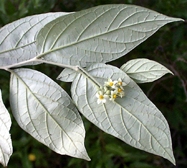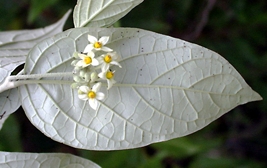 |
 |
|
habit with flower |
flower |
|
Solanum schlechtendalianum Walp.Solanaceae - Tomato Family |
|
|||||
|
|||||
|
Description. Shrub ir treelet, mature at 1.5 to 8 m; twigs slender, somewhat zigzagging, coated with dense white stellate hairs; leaves distichous, solitary, but paired where an inflorescence arises, densely covered with white, sessile and stalked stellate hairs below giving the underside a powdery white appearance, petiole to 3 mm, blade to 6 x 12 cm, ovate, acuminate, base unequal, weakly bullate veins keeled above, very strong unpleasant leaf odor; inflorescence arising next to minor leaf and bent underneath the accompanying major leaf, which hides the flowers from above; flowers with pedicel 5-8 mm, corolla 5-7 mm long, white shaded with green at base, lobes 5 mm, pubescent outside, glabrous inside, anthers 2mm, blunt, orange, ovary and base of style stellate pubescent; fruit a globose, purple-black, 1 cm berry. Similar species. Solanum argenteum is a treelet with the leaves glossy white below from scale-like hairs. Not scale-like in S. schlechtendalianum. Local distribution. Pacific slope at 700-1200 m (Los Llanos, San Rafael); Atlantic slope from lowlands to about 700 m (Chachagua, La Tigra). Habitat. Old pastures, forest edge, especially on recently disturbed soil. Species range. Mexico to South America. Abundance. Rare on Pacific slope; uncommon on Atlantic slope.
Herbivores. Phenology. FL: may; FR: Pollinators. Bees Seed dispersers. Birds? Comments. Not known to be an ithomine hostplant. The very strong leaf odor is both unpleasant and indicative. This species is more typical of disturbed ground outside if forest habitats, while S. argenteum is more often found in gaps and road margins within forest. Voucher No. Haber |
|